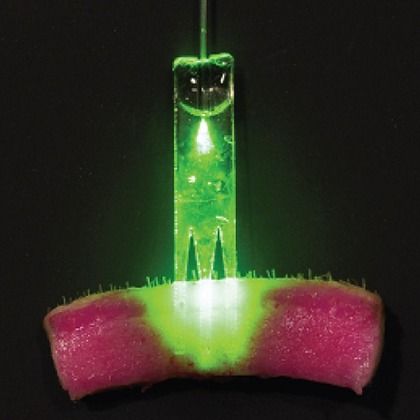Using laser to build nanostructures on metal; and watch water bounce off the nanostructure coating
https://m.facebook.com/story.php?story_fbid=880054655441835&id=778276028953032
Using laser to build nanostructures on metal; and watch water bounce off the nanostructure coating
https://m.facebook.com/story.php?story_fbid=880054655441835&id=778276028953032
Time triva facts that make you go hmmm.
Passage of time is faster for your face than for your feet (supposing you’re standing up). Einstein’s theory of relativity states that the nearer you are to the center of the Earth, the slower time passes – and this has been already measured. For an instance, at the top of Mount Everest, a year would be about 15 microseconds shorter than at sea level.
A second isn’t what just you consider it is. Technically, it’s not defined as 1/60th of a minute, but as “the duration of 9,192,631,770 periods of the radiation consistent to the transition between the two hyperfine levels of the ground state of the caesium 133 atom”.
Hmmm,
Steve Ballmer says Twitter has a great brand and lots of room to improve the product and the company’s cost structure.
As oil was to Saudi Arabia, could solar be to Morocco?
Morocco has turned on its enormous solar power plant in the town of Ourrzazate, on the edge of the Saharan desert. The plant already spans thousands of acres and is proficient of generating up to 160 megawatts of power. It’s already one of the largest solar power grids in the world, capable of being seen from space. And it’s only going to get bigger.
The present grid, called Noor I, is just the first phase of a planned project to bring renewable energy to millions living in Morocco. It will soon be followed by expansions, Noor II and Noor III, that will add even more mirrors to the present plant. Once the project is finished around 2018, the whole grid will cover 6,000 acres. It will be capable of producing up to 580 megawatts of power, comparable to that of a small nuclear reactor.
Continue reading “Morocco Turns on What will Become the World’s Largest Solar Power Plant” »

https://www.youtube.com/watch?v=LG-_Dz6nseQ&feature=youtu.be
Israel latest technology 2016 unmanned military technology subscribe and thumbs up.
 Photochemical tissue bonding (PTB) is a light-based method to repair tissues and is an alternative to traditional sutures and staples used to close wounds. Unlike the latter, PTB does not cause inflammation and scarring at the repair site. PTB works by applying light-sensitive Rose Bengal dye to the exposed tissue. When the dye is exposed to green light, the dye absorbs the light, thereby causing the tissue to crosslink and form a water-tight seal. While PTB can seal incisions sans inflammation, the technique is limited by how deep the light can penetrate the tissue. Researchers from the University of St Andrews and Harvard Medical School have developed a bioabsorable optical waveguide, which can deliver light deep into tissues before being absorbed.
Photochemical tissue bonding (PTB) is a light-based method to repair tissues and is an alternative to traditional sutures and staples used to close wounds. Unlike the latter, PTB does not cause inflammation and scarring at the repair site. PTB works by applying light-sensitive Rose Bengal dye to the exposed tissue. When the dye is exposed to green light, the dye absorbs the light, thereby causing the tissue to crosslink and form a water-tight seal. While PTB can seal incisions sans inflammation, the technique is limited by how deep the light can penetrate the tissue. Researchers from the University of St Andrews and Harvard Medical School have developed a bioabsorable optical waveguide, which can deliver light deep into tissues before being absorbed.
In a study published in Nature Communications, researchers fabricated optical waveguides from a variety of polymers, but ultimately tested the degradation times of the polymers PVP and PLGA (50:50) in vivo. They inserted 1 × 5 mm x 500 µm pieces of bulk polymer subcutaneously in mice and examined the implant at different time points. The PVP waveguide dissolved within one hour of implantation, whereas the PLGA polymer began to lose shape after 17 days, illustrating that researchers can tune the degradation time (ranging from hours to days) of the optical waveguide for a specific application.
After establishing the biodegradability of the polymer waveguides, the team showed how the waveguides could extend the penetration depth in PTB. Light was coupled to the device via pigtail fiber, which was trimmed off after light was applied, thus leaving only the bioabsorable polymer within the wound. Immediately after a pig was killed, they made a “full-thickness incision” (1 cm) on the dorsal skin and applied Rose Bengal dye. In the control, they applied 532-nm light (1 W) for 15 minutes at the surface of the wound. In waveguide assisted PTB, they inserted the polymer waveguide and applied light through the waveguide, effectively increasing the penetration depth of the light. The shear tensile strength of the control PTB was 0.33 kPa compared to 1.94 kPa in the waveguide assisted PTB, illustrating that the optical waveguide enabled tissue crosslinking and wound healing at greater depths.
Chameleons are masters at rapidly changing the color of their skin to camouflage themselves or communicate with others. Scientists worldwide have long sought to mimic the skins of these reptiles to render people effectively invisible with chameleon suits.
Now a mechanical chameleon from China can change color to almost every hue in the visible spectrum with the aid of bumps made of gold and silver on its skin, researchers say. The scientists published their work this past month in the journal ACS Nano.
